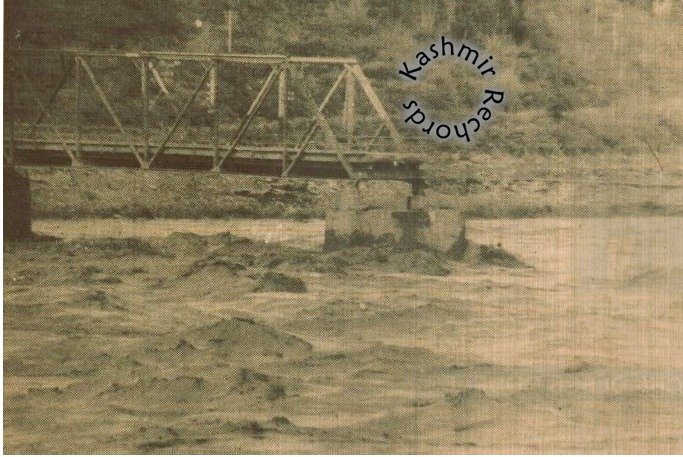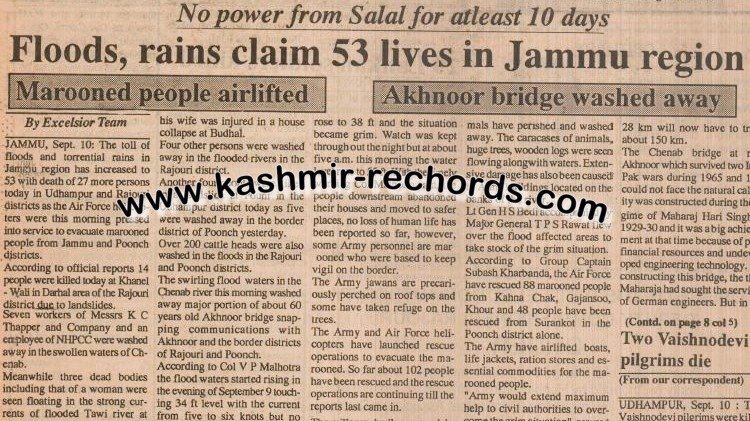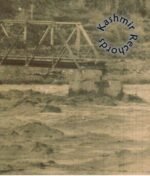
When Chenab Swept Away Maharaja Hari Singh’s Iconic Akhnoor Bridge!
(Kashmir Rechords Exclusive)
Torrential August 2025 rains and lethal flash-floods in Jammu hills have reopened a grim chapter in the region’s collective memory: September 1992, when the Chenab River roared through Akhnoor and tore away a span of the historic Karan Bridge, built during the regime of Maharaja Hari Singh.
Back then, the disaster marked one of the most severe monsoon-driven floods in Jammu and Kashmir’s history. Today, more than three decades later, nature seems to be replaying the same fearsome script—short-fuse cloudbursts, surging tributaries, collapsing banks and strategic bridges once again under stress.

The Night the Bridge Gave Way
Between 7–10 September 1992, a chain of extreme monsoon pulses pounded the Chenab–Jhelum basin, driving river levels to unprecedented heights. At Akhnoor, the Chenab reportedly swelled to around 61 feet—an enormous surge that battered the Dogra-era steel Karan Bridge, built in 1933–34 under Maharaja Hari Singh and named after Dr. Karan Singh.
On the night of 9–10 September, one of its key spans gave way. Connectivity to the border belt was severed, and for months the Army had to improvise temporary bridging and boat crossings until a rebuilt span reopened in April 1994.
The 1992 deluge also caused widespread devastation across Jammu, Kashmir, and northern Pakistan—sweeping away villages, farmlands and roads, and claiming scores of lives. Its hydrograph is still a reference point for Chenab flood modeling today.

2025: A Grim Reminder
Fast forward to August 2025. Jammu recorded 190.4 mm of rain in just 24 hours—its second-highest August total in a century—triggering urban flooding, landslides and damage to the Jammu–Pathankot highway bridge.
Earlier, a deadly cloudburst on 14 August over Chosoti in Kishtwar unleashed flash floods along the Machail Mata pilgrimage route, leaving dozens dead and hundreds missing. Kathua’s upper reaches also faced similar destruction.
The parallels with 1992 are chilling:
- Multi-day monsoon surges loading the Chenab and Tawi rivers.
- Short, intense cloudbursts triggering flash floods in steep catchments.
- Strategic crossings vulnerable, exposing gaps in disaster preparedness despite decades of lessons.
A Region of Cloudburst Memories
The tragedy is not isolated. Jammu & Kashmir has endured a pattern of cloudburst-linked disasters:
- Leh’s night-time cloudburst (2010) killed scores.
- Kargil (2013) saw town-level damage.
- The basin-wide floods of 2014 brought Kashmir to a standstill.
- Doda (2017), Kishtwar (2021), Amarnath (2022), and multiple incidents in 2023 reinforced the trend of rising frequency of short-burst extremes.
Through the Akhnoor Prism
Thirty-three years after the Karan Bridge loss, August 2025 has revived old fears. The message is clear—river crossings across the Chenab-Tawi belt remain vulnerable to the twin threat of climate-driven monsoon surges and localized cloudbursts.
For Akhnoor, the past is not just history; it is a warning etched in steel and water—one that the present can no longer afford to ignore.
“The river has a memory,” says a 75-year-old Akhnoor resident, recalling the 1992 night.
“When it rises, it reminds us that steel and concrete mean nothing without respect for nature’s fury.”
The message is stark—bridges across the Chenab-Tawi belt remain vulnerable to climate-driven extremes. The 1992 loss of Karan Bridge was not just a tragedy; it was a warning. August 2025 proves that warning still stands.




